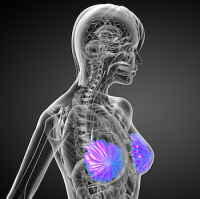Radiomics is an image analysis approach that has the potential to improve the management of cancer patients, but further research is required before it can be adopted into routine clinical practice, according to an article published in the journal eLife.
Medical imaging techniques underpin much decision-making in cancer medicine and can be used to determine, among other things, the size of a tumour and if it has spread into the surrounding tissue or other parts of the body. These and other tumour characteristics act as prognostic indicators and can help clinicians assign treatments for patients and monitor their response to therapy – a strategy known as "personalised medicine".
However, only a few imaging techniques can be used as companion diagnostic tools or as predictive biomarkers that can identify which patients are likely to benefit from a specific therapy. Interestingly, a team of researchers led by Hugo Aerts, Robert Gillies and Philippe Lambin – including Patrick Grossman as first author – have reported on how radiomics could be used to enhance personalised medicine, the journal article notes.
Radiomics uses computer algorithms to process the data collected by different medical imaging techniques and is becoming increasingly popular in cancer imaging research. One of its key characteristics is that radiomics recognises that digital medical images are not only pictures – they are also are complex data. Radiomic analyses extract and measure an array of "features" that describe the image texture and distributions of individual voxel values – the units that make up a 3D image – within a tumour. Each voxel represents a tiny amount of tissue and contains neoplastic and stromal cells, depending on tumour type and voxel dimensions. Features can be descriptive terms derived from radiology reports or mathematical quantities.
In their study, Grossman et al. discovered a connection between the radiomic phenotype of a tumour, the signalling pathways inside cells that drive how cancer develops, and clinical treatment outcomes. The study demonstrates the potential strength of radiomics, especially when combined with genomic and clinical information.
"One of the main benefits is that medical imaging data acquired in routine healthcare can be used in a new way to inform clinicians about the biology of a tumour and provide potential prognostic or predictive information," the article says. Moreover, radiomic image analysis is a non-invasive procedure that provides three-dimensional reconstructions of a tumour and avoids the problems associated with samples obtained through invasive biopsies.
The article says several challenges need to be overcome before radiomics can be used as a companion diagnostic or predictive tool. First, significant statistical problems can arise from analysis of such "big data", with overfitting leading to relationships being seen were there are none (false discovery). Second, the terminology used for the derived image features needs to be standardised. At present, different investigators use their own names for the features, which makes it difficult to compare data between studies.
In addition, the number of features incorporated into radiomic analyses appears to vary even within individual research groups, leading to a phenomenon termed "biomarker drift". Picture Archiving and Communications System (PACS) platforms also need to be adapted to integrate with radiomics algorithms in order to enable widespread clinical use, the article says.
Source: eLife
Image Credit: LindaShell.com
Medical imaging techniques underpin much decision-making in cancer medicine and can be used to determine, among other things, the size of a tumour and if it has spread into the surrounding tissue or other parts of the body. These and other tumour characteristics act as prognostic indicators and can help clinicians assign treatments for patients and monitor their response to therapy – a strategy known as "personalised medicine".
However, only a few imaging techniques can be used as companion diagnostic tools or as predictive biomarkers that can identify which patients are likely to benefit from a specific therapy. Interestingly, a team of researchers led by Hugo Aerts, Robert Gillies and Philippe Lambin – including Patrick Grossman as first author – have reported on how radiomics could be used to enhance personalised medicine, the journal article notes.
Radiomics uses computer algorithms to process the data collected by different medical imaging techniques and is becoming increasingly popular in cancer imaging research. One of its key characteristics is that radiomics recognises that digital medical images are not only pictures – they are also are complex data. Radiomic analyses extract and measure an array of "features" that describe the image texture and distributions of individual voxel values – the units that make up a 3D image – within a tumour. Each voxel represents a tiny amount of tissue and contains neoplastic and stromal cells, depending on tumour type and voxel dimensions. Features can be descriptive terms derived from radiology reports or mathematical quantities.
In their study, Grossman et al. discovered a connection between the radiomic phenotype of a tumour, the signalling pathways inside cells that drive how cancer develops, and clinical treatment outcomes. The study demonstrates the potential strength of radiomics, especially when combined with genomic and clinical information.
"One of the main benefits is that medical imaging data acquired in routine healthcare can be used in a new way to inform clinicians about the biology of a tumour and provide potential prognostic or predictive information," the article says. Moreover, radiomic image analysis is a non-invasive procedure that provides three-dimensional reconstructions of a tumour and avoids the problems associated with samples obtained through invasive biopsies.
The article says several challenges need to be overcome before radiomics can be used as a companion diagnostic or predictive tool. First, significant statistical problems can arise from analysis of such "big data", with overfitting leading to relationships being seen were there are none (false discovery). Second, the terminology used for the derived image features needs to be standardised. At present, different investigators use their own names for the features, which makes it difficult to compare data between studies.
In addition, the number of features incorporated into radiomic analyses appears to vary even within individual research groups, leading to a phenomenon termed "biomarker drift". Picture Archiving and Communications System (PACS) platforms also need to be adapted to integrate with radiomics algorithms in order to enable widespread clinical use, the article says.
Source: eLife
Image Credit: LindaShell.com
Latest Articles
Cancer, personalised medicine, radiomics, image analysis
Radiomics is an image analysis approach that has the potential to improve the management of cancer patients, but further research is required before it can be adopted into routine clinical practice, according to an article published in the journal eLife.



























